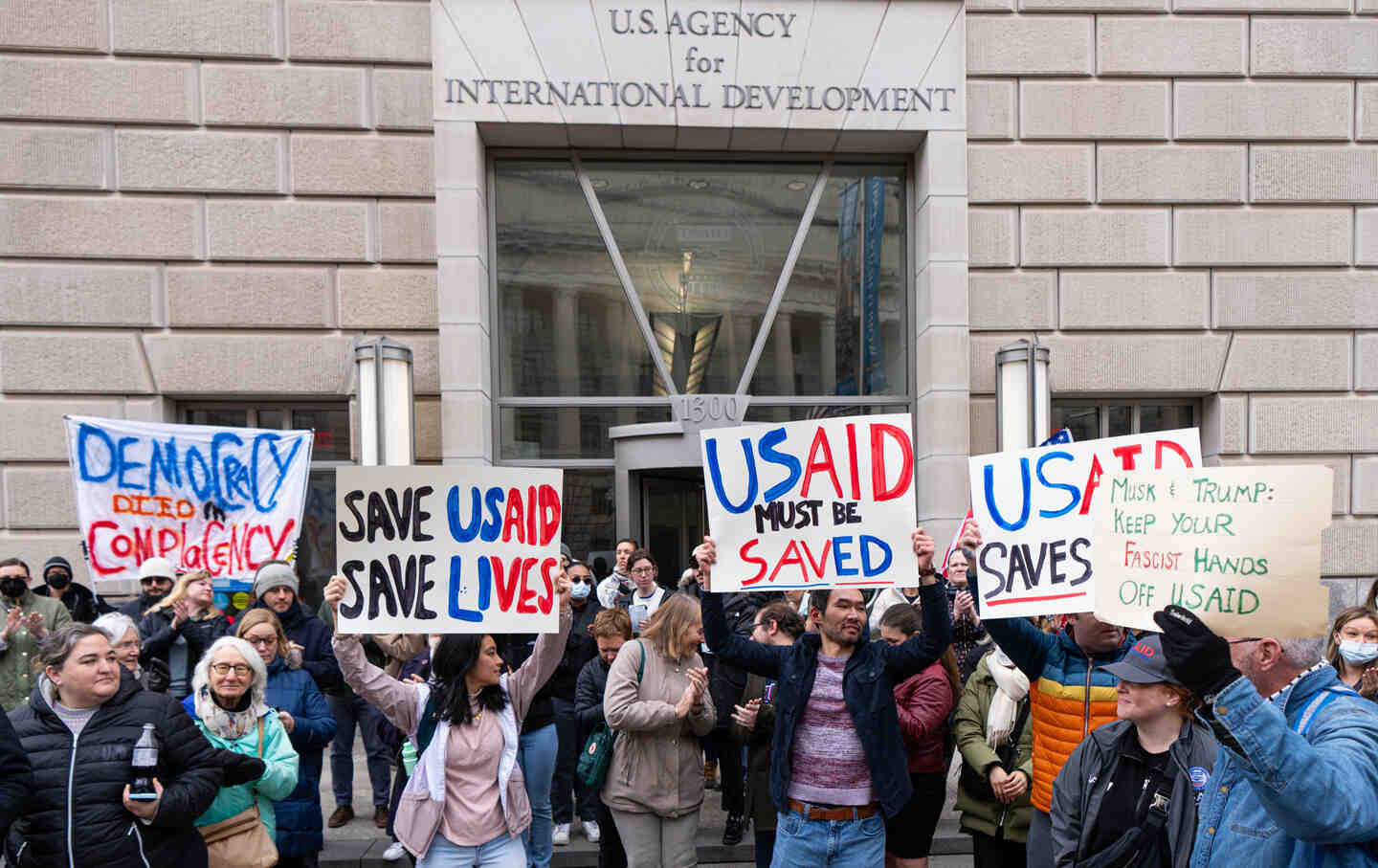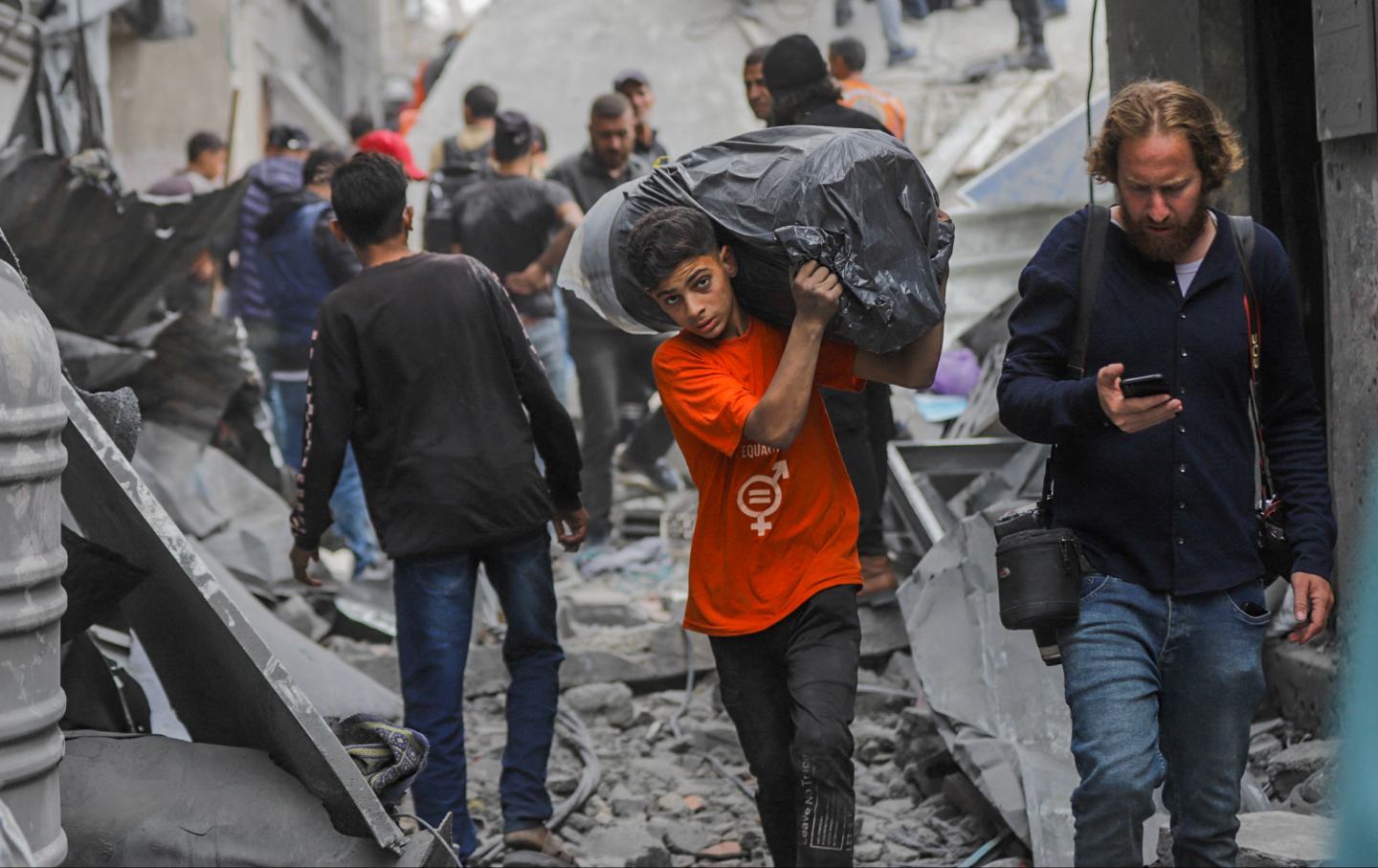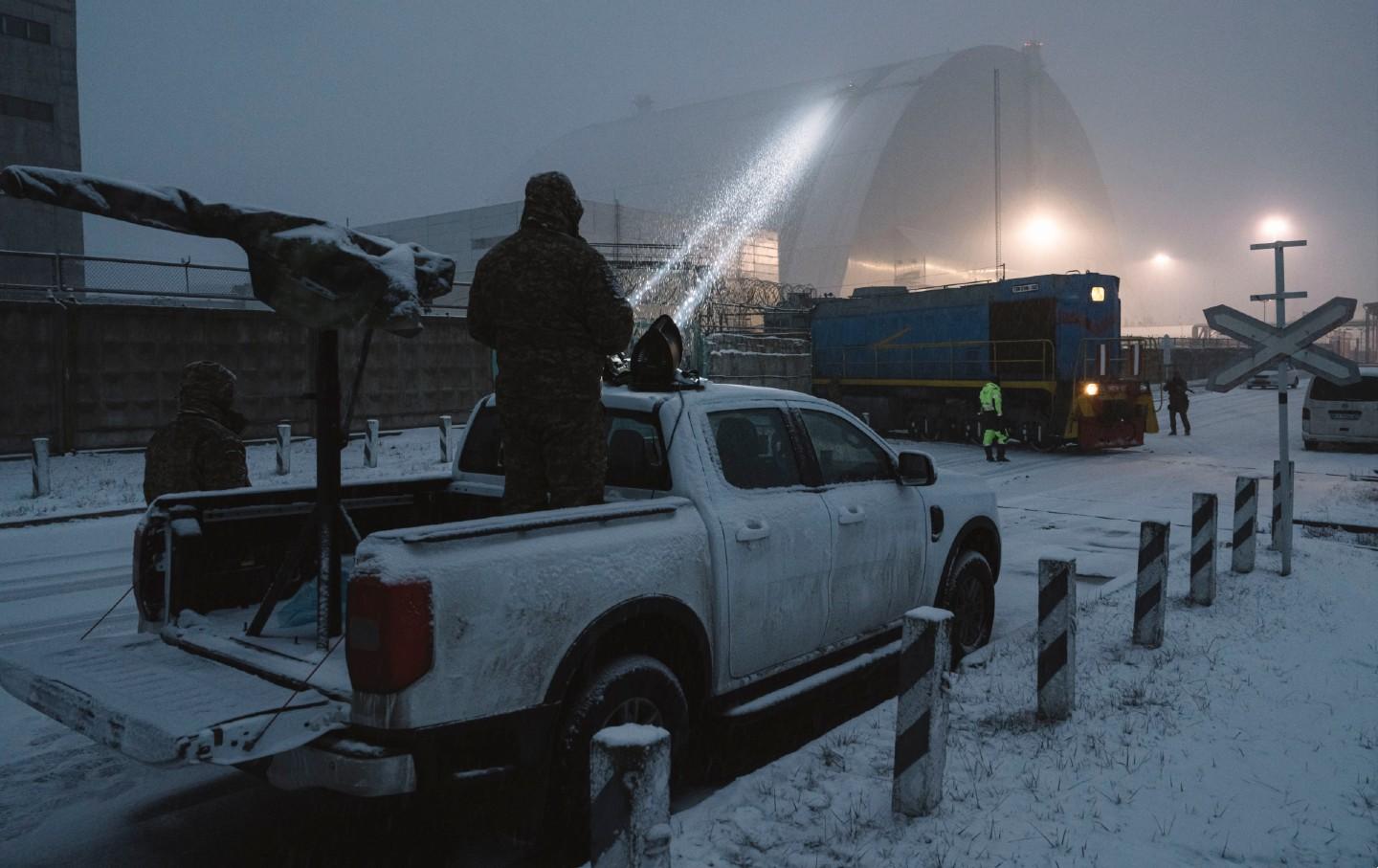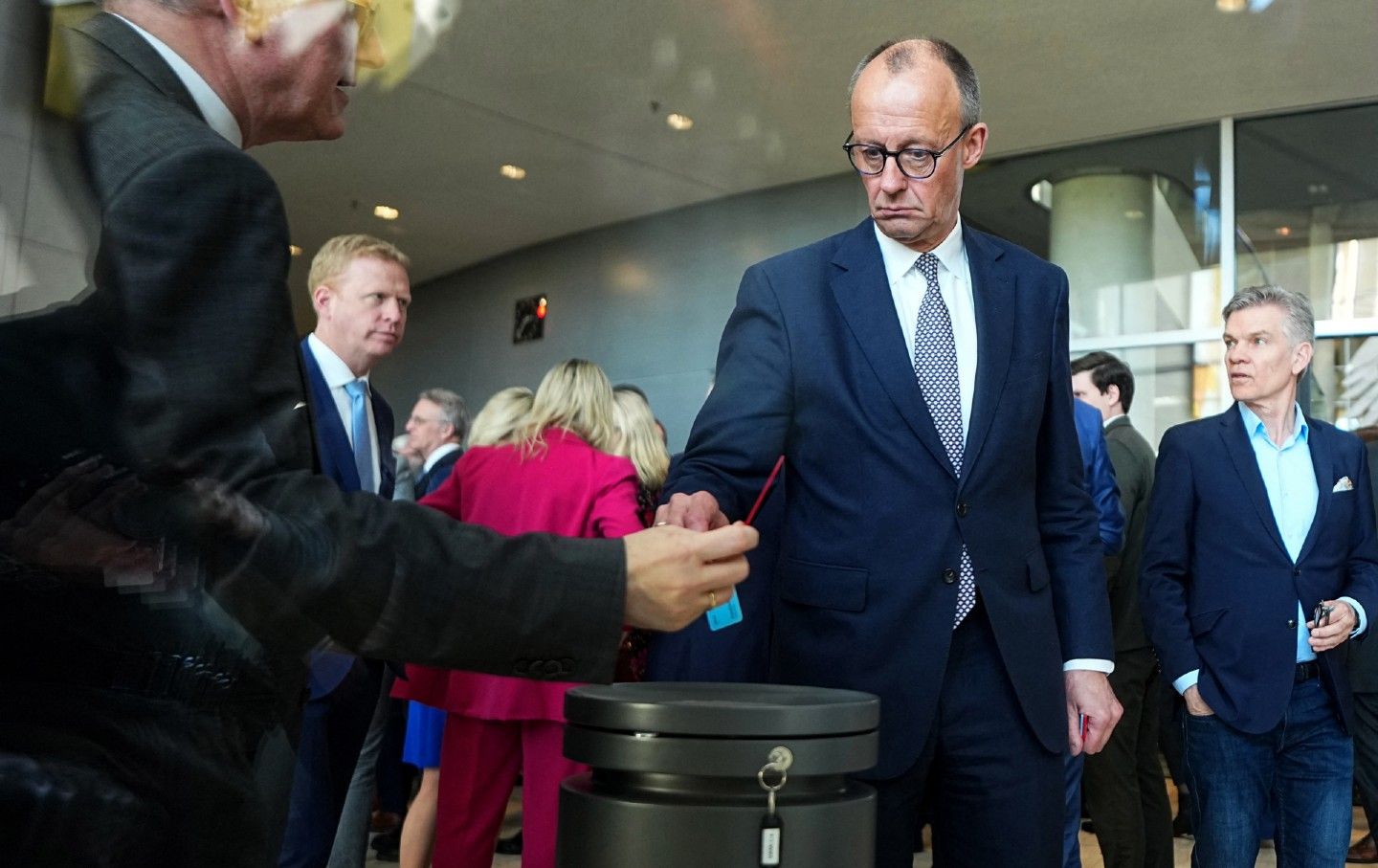A Tour of a Cartel “Extermination Camp”
At a Jalisco ranch, investigators found bone fragments and three suspected crematoria. Families visited the camp, hoping to find clues about their missing family members.
Families Try to Find Answers at a Cartel “Extermination Camp” in Mexico
At a Jalisco ranch, investigators found bone fragments and three suspected crematoria. Families toured the camp, hoping to find clues about their missing family members.
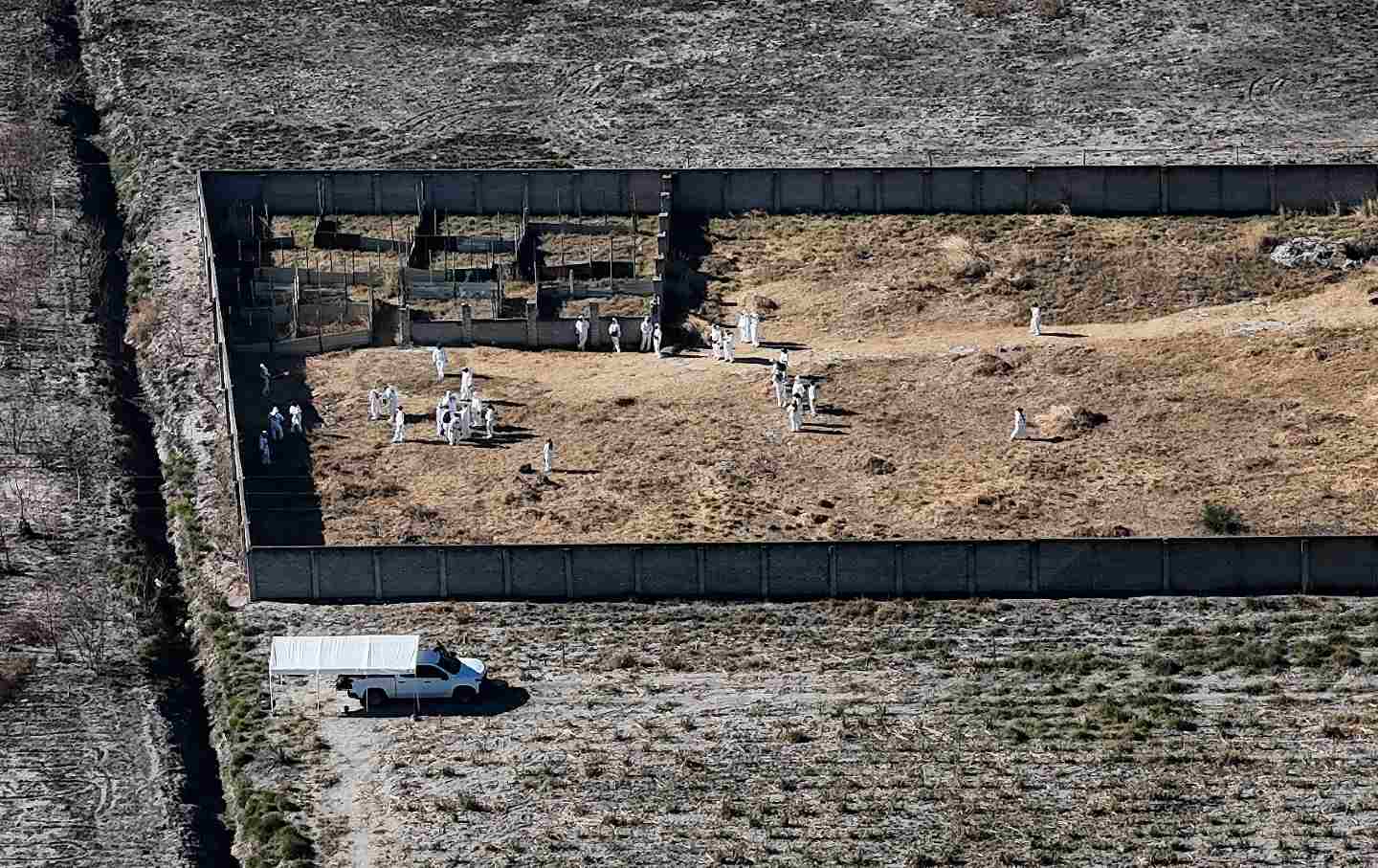
This aerial picture shows white-clad forensic experts from the Mexican Attorney General’s Office walking inside the alleged organized crime “extermination camp” in the municipality of Tehuchitlan, Jalisco, Mexico, on March 28, 2025.
(Ulises Ruiz / AFP via Getty Images)
Izaguirre Ranch, Jalisco, Mexico—Tired of waiting for permission to enter, dozens of people surged past the state police guarding the entrance of the Izaguirre Ranch, a suspected extermination camp, near Teuchitlán in the Mexican state of Jalisco. That day, March 20, they had already traveled an hour from the state capital and then waited in the sun in hopes of being allowed inside, where they expected to receive news about their missing relatives.
“All I want is to go inside and see if my daughter was there,” Patricia Sotelo, whose daughter Fanny Areli disappeared in 2021, cried out to the press. “They’ve turned this into a museum of pain.”
Earlier that month, the Fighting Searchers of Jalisco—a collective of citizens dedicated to finding their relatives, dead or alive—had wanted to inspect the ranch after an encounter last September between the National Guard and organized crime had led to the camp’s discovery. The state government started an investigation, but six months later, it appeared to have stalled.
The National Guard found human remains, and the the collective believed that it might find traces of their disappeared sons, sisters, and husbands inside, so they headed to the site with picks and shovels themselves. Upon entering the Izaguirre Ranch, just outside the town of La Estanzuela, they found hundreds of torn-up personal belongings and what appeared to be the remnants of three crematoria.
The ranch appeared to have served as a training and extermination camp for the Jalisco New Generation Cartel (CJNG). Presumably, people taken there met one of two fates: They were either killed or forcefully recruited into the cartel.
(In a video published days later, a group of masked, armed men claiming to belong to the CJNG stated the cartel had nothing to do with the ranch. “Why are you trying to tarnish our reputation?” the apparent leader said. “What are [the searching mothers] hiding? Who’s backing them?”)
The Fighting Searchers of Jalisco had livestreamed their expedition into the camp. Soon, photos of shoes, backpacks, and clothes started to circulate the Internet. Margarita Balvaneda identified a backpack that she thought could have belonged to her daughter Perla Yajaira, who was taken by armed civilians last year. Alejandrina Orozco saw a pair of shoes that were identical to the ones her son, Pablo Gómez, had last worn before his disappearance in 2023. Another pair of shoes might have belonged to Eduardo Reyes’s son, Rubén Eduardo Reyes, who was forcibly taken from a gas station seven years ago.
The collective also found a letter signed by Eduardo Lerma, a 20-year-old who’d been reported missing in February 2024. It read, “My love, if I don’t come back one day, I just ask that you remember how much I love you.”
After local authorities again took over the investigation, guards locked off the premises, shutting out civilians from the Izaguirre Ranch.

20 Years of Violence
Since then-President Felipe Calderón declared war on the cartels in 2006, Mexico has seen a spike in homicides and forced disappearances. There are currently 126,523 missing people throughout the country, according to the National Registry of Disappeared and Not Located People. Jalisco registers the highest number among all states with 15,056.
Claudia Alarcón, a researcher at the National Autonomous University of Mexico who studies conflict and punishment, points out that the states with the most disappearances are also the states that have seen the most people emigrate. “It’s the story of places like Jalisco, Michoacán, Oaxaca, and Veracruz,” she told me, referring in part to the thousands of children who are left behind in these states when their parents migrate to the US in search of better economic opportunities.
“We can also think of cases like Tabasco, where you either work for the national gas and oil company, PEMEX, or for the state,” she added, noting the lack of opportunities for upward mobility and the links between municipal governments and organized crime.
The lack of jobs left a gap that organized crime stepped in to fill. A study by the Complexity Science Hub found that cartels are the fifth-largest employer in the country, with upward of 150,000 members. They put out fraudulent job offers—often for positions such as security guards—to attract young people before kidnapping and forcing them into a grueling training from which not everyone survives.
The promise of a well-paying job is particularly enticing to the cartels’ main target: people aged 10 to 29. Mary Vázquez has been searching for her 20-year-old son, Ángel de Jesús López, for three years. “He called me and said, ‘Mom, I’ve got a job now.’ Doing what? I don’t know. He was just excited to have work,” she said. Her latest clues as to his whereabouts are the pictures that first circulated when the Fighting Searchers of Jalisco found the Izaguirre Ranch. She believes one of the hats in the pictures could’ve been her son’s.
The same hoax was used to take Abisaí Aguilar, who was reported missing in 2024 after the 18-year-old took a bus to Tlaquepaque in the outskirts of Jalisco’s capital. He’d been promised a job that paid $500 a week, an opportunity he couldn’t pass up. Like many others, his disappearance was ruled a “voluntary absence” and dismissed by local law enforcement.
Unlike López, however, Aguilar has already been found. Last February, his family received a call alerting them that their son had been detained, accused of carrying heavy weaponry that only the Mexican army is allowed to use. Authorities determined that he’d spent time at the Izaguirre Ranch before joining the ranks of the CJNG.
Aguilar is now facing prison, but his family insists he was a victim of forced recruitment and have asked that his circumstances be taken into consideration. “His only mistake was his desire to get a well-paying job and to provide me and his sister with a better life,” his mother Jenny told Mural.
Outside the ranch, María de la Luz Vázquez expressed a similar sentiment. “The disappeared should be found, not judged. Only then, if they have a debt to pay to society, should they get due process.” She’s been searching for her husband Juan José Ramos since he was disappeared six years ago.
“Many people ask, ‘How is it that they didn’t realize it was a fraudulent job offer and that they were walking into a dangerous situation?’ But we must remember that’s what it often means to be young,” Alarcón added. “It comes from ignorance, from the naïveté of youth.”

A Museum of Pain
Two weeks after the Fighting Searchers of Jalisco broke into and filmed the site, Attorney General Alejandro Gertz Manero acknowledged that the Jalisco State Prosecutor’s Office had mishandled the investigation. “[Local authorities] did not register or identify the items found,” he said, referring to the 200 pairs of shoes and other personal belongings left behind. “The state’s forensic experts have not yet come to a definitive conclusion about the identity of the remains or how long they’ve been there. They have also not conducted the proper physical and chemical analyses on the trenches that show signs of possible crematory activity.”
Popular
“swipe left below to view more authors”Swipe →Gertz Manero invited the press and families to visit the Izaguirre Ranch the next day, promising to provide further details. But about three hours before the buses provided by the attorney general were set to depart toward Teuchitlán, President Claudia Sheinbaum announced that the federal government needed more time to look at the case. But none of the families were notified of this, and the buses to the ranch left full of people expecting answers upon arrival.
A little over a mile away from the site, the buses stopped, and the vans that were supposed to take the families the rest of the way never showed up. Federal authorities were nowhere to be found.
“¡Queremos entrar!”—“We want to go inside!”—the families screamed in unison as they marched past the state police guarding the periphery of the ranch.
Mothers led the way toward the gates, where they demanded entry into the camp where they believed their loved ones could have been held. Local authorities finally relented and told relatives they could enter in small groups. But going inside crushed any remaining hopes that they could find answers on their own.
Once reporters were allowed inside, it was clear why: There was nothing left. All the items that the Fighting Searchers of Jalisco had filmed were gone.
“They should let us dig! They’ll see that we can find more traces of our disappeared,” said Vázquez. She’d seen pictures of a belt that looked like her husband’s and was hoping to confirm whether it was indeed his. She was told all personal items had been taken by the Forensic Medical Service, and she worried it’d now be too difficult to jump through the bureaucratic hoops required for her to examine the belt.
Various searching collectives, including the Fighting Searchers of Jalisco, filed a complaint to the National Human Rights Commission about the case. “It’s a mockery,” said Liliana Meza, who’s been looking for her son Maximiliano Romero for the past five years. “The federal government is the one who invited us and the one we wanted to talk to.… Are we as a country waiting until every single family has a disappeared relative?”
El País has since reported on a forensic evaluation that confirmed not only that the ranch may have harbored crematoria but that these could have been in operation since at least 2019. Law enforcement, too, has made progress on one front, arresting a man believed to have been a recruiter for the CJNG as well as three former police officers.
But families are still looking for their loved ones. Vázquez told the press that many of the searchers suffer chronic illnesses from the stress they live under, and that they left the ranch feeling enraged and impotent. In a letter addressed to Sheinbaum last week, the Fighting Searchers of Jalisco renewed their plea: “It’s time to find our disappeared.”
Hold the powerful to account by supporting The Nation
The chaos and cruelty of the Trump administration reaches new lows each week.
Trump’s catastrophic “Liberation Day” has wreaked havoc on the world economy and set up yet another constitutional crisis at home. Plainclothes officers continue to abduct university students off the streets. So-called “enemy aliens” are flown abroad to a mega prison against the orders of the courts. And Signalgate promises to be the first of many incompetence scandals that expose the brutal violence at the core of the American empire.
At a time when elite universities, powerful law firms, and influential media outlets are capitulating to Trump’s intimidation, The Nation is more determined than ever before to hold the powerful to account.
In just the last month, we’ve published reporting on how Trump outsources his mass deportation agenda to other countries, exposed the administration’s appeal to obscure laws to carry out its repressive agenda, and amplified the voices of brave student activists targeted by universities.
We also continue to tell the stories of those who fight back against Trump and Musk, whether on the streets in growing protest movements, in town halls across the country, or in critical state elections—like Wisconsin’s recent state Supreme Court race—that provide a model for resisting Trumpism and prove that Musk can’t buy our democracy.
This is the journalism that matters in 2025. But we can’t do this without you. As a reader-supported publication, we rely on the support of generous donors. Please, help make our essential independent journalism possible with a donation today.
In solidarity,
The Editors
The Nation

